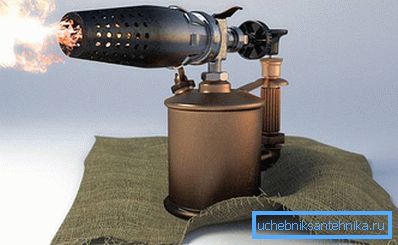What to do if the sewage system is frozen
In regions with low winter temperatures, icing of the outer part of the sewer system is not uncommon. In such a situation it becomes impossible to use the sink in the toilet, bathroom, kitchen. The problem requires urgent solutions. Find out what to do if the sewage system is frozen.
Causes of ice in the sewer

With proper installation of sewer pipes in them there is no water, therefore, it can not freeze. If an ice block formed in the system, it means that the pipeline laying technology was broken. Consider some of the causes of this problem:
- With insufficient slope - less than 20 mm per 1 meter - the drains do not completely merge into a septic tank, but stagnate and freeze in the pipe. The second reason is that the diameter of the installed pipes is less than 110 mm; the liquid moves slowly through thin channels and has time to crystallize.
- Insufficient depth of pipe laying. External distribution of sewage in a private house should take place at a depth below the freezing point. If we ignore this rule, then in winter the cold will get to the pipes.
- Violations in the device septic tank. The insufficient area of the filtration field to drain water from the septic tank, or the shallow depth of placement of the drainage pipes lead to the termination of the withdrawal of the liquid from the sump. The level of effluent in the septic tank rises and closes the opening of the outflow pipe. Sewerage from the house does not flow into a crowded well, stagnates in the pipe and freezes. It will not be possible to alter the drainage system in the winter, it will be necessary to periodically call up an after-sewer machine and pump out sewage until spring.
- Small leaks provoke freezing of a thin crust of ice on the walls of the outflow pipe. Over time, a cork of substantial length forms that does not allow waste water to flow into the septic tank. It is necessary to identify the place of leakage (tap or toilet tank), eliminate it, and then defrost the pipe.
Universal way to warm sewage

Hot water with added salt is an effective method of dealing with ice cork for any kind of pipes. Before you warm the sewer, you need to find a place for freezing. To do this, a metal cable is pushed into the pipe, it is pushed up to the cork. The length of the ice is calculated along its length. If the pipe is frozen near the exit from the house, then the hose for pouring boiling water starts up from the side of the building. If an ice block is found near the septic tank, defrosting is carried out from there. A rigid hose or a metal-plastic pipe is pushed down the drain to the ice plug and salty boiling water is poured through the funnel. 1–2 kg of salt fall asleep on a bucket of boiling water.

If the work is carried out by the septic tank, then the thawed drains together with water will flow into it. When defrosting from the basement of the house you need to stock up on containers for collecting water. Work takes several hours if a massive traffic jam has formed. It is impossible to stop it before complete thawing, because the sewage system is completely filled with water, and this threatens to freeze along the entire length of the pipes. If the process needs to be interrupted, pump out the filled water.
Tip! This universal method is suitable for all materials and will not damage the pipes, but it will not be possible to use them when constructing a sewage system with several turns.
Defrosting cast iron pipe

Metal pipes can be heated from the inside and outside, in the second case, the use of open fire is permissible. But before you defrost the pipe, you need to dig up the winter soil in order to free the pipes that are underground. You can warm the sewage system by directing the flame of a gas burner to it, if there is no such device in the household, make a fire directly at the place where the ice block formed. The use of a flammable liquid (gasoline, kerosene) will help to make a fire quickly. Firewood will be required for a long burning.

Industrial hair dryer is also a good tool for heating the cast-iron pipe, drive them around the frozen area, trying to warm it evenly. At the first signs of thawing, the actions are complemented by pouring boiling water into the system.

You can warm the system with the help of electricity. There are several ways:
- A special heating cable is wound on the pipe and covered with a heat insulating material so that the temperature does not fall under the effect of frost. Extension cords are required for electrical connection.
- Electricity is passed through the whole pipe if the freezing point is not found, or through its section through two connected terminals. To ensure the safety of others, a step-down transformer or a device specifically designed for this purpose is used. Heating takes several hours, after which boiling water is poured into the sewage system.
Plastic pipe heating

Polymer pipes used in laying sewers should not be exposed to fire or excessive heat can be created with an industrial dryer. The current through it, too, will not miss. Smooth sections are heated with a directional hose with hot water, and for a curved sewage system they make a more complex device. It must be flexible and tough enough to break the ice. To supply boiling water, an elastic hose is taken from the water level, on which the wire with a curved edge is fixed with the help of adhesive tape. Hot water is poured into the pipe using an Esmarch cup, but if it is not there, make a simple structure yourself. Make a hole in the cork of a plastic bottle and secure the end of the hose in it. Cut the bottom of the bottle, then screw the cap and pour water through this funnel. Flexible slug easily overcome all turns, and hard wire will help to crush the ice.

To heat a plastic pipe, a building dryer is suitable, only the temperature should not be higher than 100 degrees. It is possible to increase the heating efficiency by erecting a kind of polyethylene sleeve on the pipe section. On the one hand, it is tightly tied with wire or rope, and on the other, the hair dryer is turned on.
If the whole sewer pipe has been excavated, then it is defrosted and simultaneously insulated with a special heating cable. It is wound over the entire length, covered with foil tape and insulation. After warming up the ice, the device is not removed, it will continue to work until spring. Using a resistive cable, you can adjust its operation. Self-regulating heating turns on in areas at low temperatures and turns off after it increases.
When outside access is not possible, a plastic pipe heater is manufactured. Teng and a plate for its fixing are taken, the sizes of devices must be less than the cross section of the sewer pipe. The ends of the heater are well insulated, a guide (plastic tube, rigid wire) is pushed onto a plate made of wood to push it to the ice plug. Water is poured into the pipe and the heating element is turned on, it is pushed up to the obstacle and connected to the network. It remains to wait and periodically push the device forward as the ice melts.
Professional devices for heating sewage

To defrost sewage professional companies use a steam generator. A steam pipe with a metal tip is directed into the frozen pipe and jets of steam are fed through the holes under pressure. This method quickly and effectively removes ice and cleans the pipe. There is nothing difficult in it, only the presence of a steam generator is required. By a similar principle, the hydrodynamic installation works, only it uses not steam, but heated water.
During the winter season, periodically warm up your sewage system with boiling water, and in the spring, perform insulation so that the problem does not reappear.
Video
In this video, the author shows the process of defrosting the discharge of water in a private house: